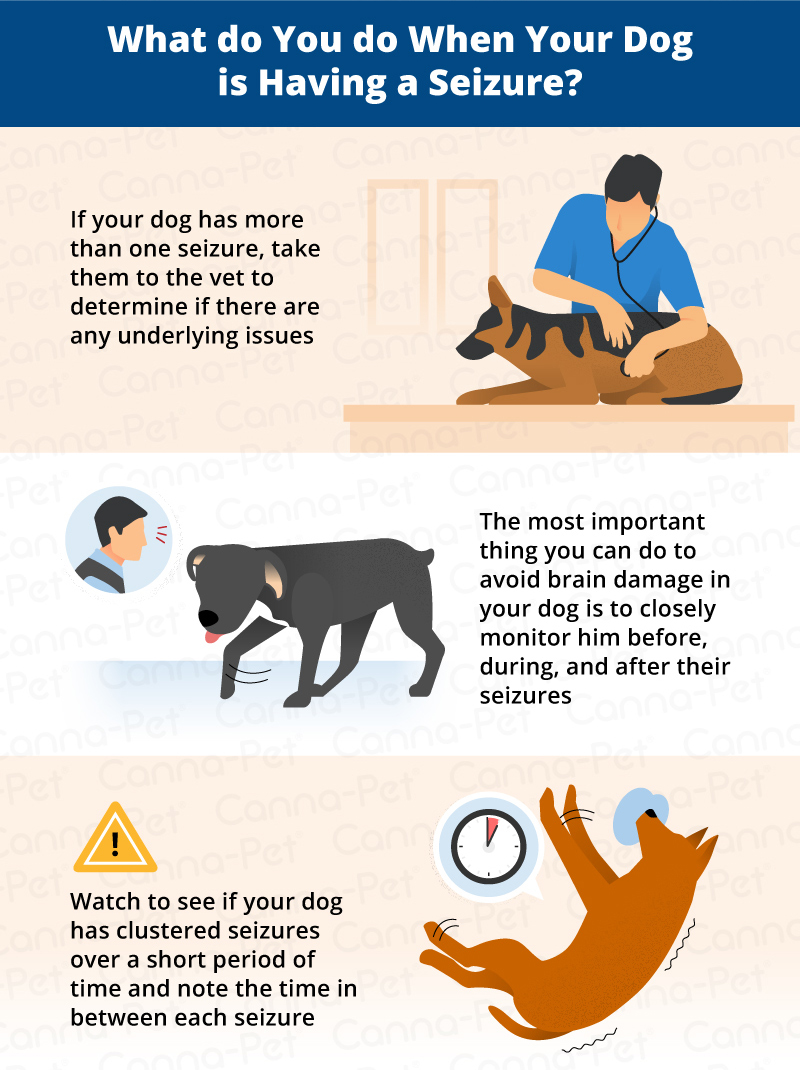Witnessing your dog having a seizure can be a traumatizing experience. When your dog is shaking uncontrollably on the ground, you feel helpless and scared. But seizures are relatively common, especially for certain breeds.
Owners, understandably, worry about the long-term effects of seizures in dogs. Most seizures result in little to no side effects, but there are certain factors – including the type of seizure, length of seizure and frequency – that will determine whether your dog will suffer permanent effects from seizures, including brain damage.
What is a Seizure?
Think of a dog’s brain like a computer. There are different processors, wires, and data that must work together to tell the body what to do. And just like your computer, those individual parts in your dog’s brain sometimes go haywire. A seizure is the result of abnormal electric activity in your dog’s brain.
The activity is normally localized – like a quick fire in a certain area of the brain. That’s why seizures cause shaking, muscle contractions, and even foaming at the mouth. Neurons are firing off and telling your dog’s body to do things it normally would not.

Types of Seizures in Dogs
Different types of seizures in dogs have different effects and originate from different parts of the brain. The first time your dog has a seizure it will be hard to tell what type of seizure it is, but ongoing monitoring of your dog will help you gain a better understanding of what is happening to him, and why.
Grand Mal: The most severe type of dog seizure is the grand mal seizure. Grand Mal seizures last from a few seconds to a few minutes. They are sometimes called generalized seizures, since they affect the entire brain and body. Grand Mal seizures can become dangerous – and lead to brain damage – if they occur continuously.

Focal: A focal seizure happens when electric activity fires off in a concentrated area of the brain. Unlike Grand Mal seizures, focal seizures affect only one side of the body and brain. This is why your dog may appear to convulse in one leg and not the other. Focal seizures are generally short, lasting only a few seconds.

Psychomotor: During a psychomotor seizure, your dog will exhibit strange behavior – like attacking an imaginary object. Each time your dog has a psychomotor seizure, he will exhibit identical behavior.

Idiopathic Epilepsy: Dogs that suffer from multiple seizures are often suffering from Idiopathic Epilepsy. This condition, which results in seizures that arise for no particular reason is genetic. It is passed down through family lines, and is more common in certain breeds, including Beagles, Keeshonds, Golden Retrievers, Labrador Retrievers, Vizslas, Shelties, Bernese Mountain Dogs, Saint Bernards, Border Collies, and German Shepherds.

Can a Dog Get Brain Damage from A Seizure?
The short answer is yes, but it’s not common. Seizures are generally short-lived, lasting a few seconds to a few minutes. As such, they have little lasting effect on the brain. However, multiple seizures over a short period of time – called “cluster seizures” – can result in brain damage.

Dogs who suffer from Idiopathic Epilepsy are most in danger for multiple seizures, and should be monitored closely during and after the initial seizure. When a dog has a seizure, his body temperature rises. When seizures are clustered together, the dog’s body temperature can remain elevated for extended periods of time, which can cause brain damage and other health issues.
What to Do When Your Dog Has a Seizure
If your dog has more than one seizure, you should take him to your vet to determine if there are any underlying issues that are causing seizures. If your dog is diagnosed with Idiopathic Epilepsy, your vet will develop an ongoing treatment plan, since your dog will likely suffer from seizures throughout his life.

The most important thing you can do to avoid brain damage in your dog is closely monitor him before, during, and after seizures. Watch to see if your dog has clustered seizures over a short period of time, and if possible, note the time in between each seizure. This information can help your vet determine your dog’s risk for brain damage.
If your dog suffers from Idiopathic Epilepsy, he will most likely live a long, happy, and healthy life. Brain damage, while possible, does not occur in most dogs who suffer from seizures. Just keep an eye on your dog and make sure he gets treatment that works for both you and him.
Sources:
- “How to Treat Seizures and Brain Disease in Dogs.” The Spruce Pets, Accessed 2 April 2017. www.thesprucepets.com/seizures-and-your-dog-1117421.
- “Seizures in Dogs: Causes, Symptoms, & What to Do.” WebMD, Accessed 2 April 2017. www.pets.webmd.com/dogs/dog-seizure-disorders#1.
- “Canine Epilepsy and Seizures.” Blue Cross, Accessed 2 April 2017. www.bluecross.org.uk/pet-advice/canine-epilepsy-and-seizures-dogs.
- Barchas, Eric. “What Causes Dog Seizures and How Should They Be Treated?” Dogster, 26 Dec. 2017, Accessed 2 April 2017. www.dogster.com/lifestyle/dog-health-seizures-ask-a-vet.
- “Brain Injury in Dogs – Symptoms, Causes, Diagnosis, Treatment, Recovery, Management, Cost.” WagWalking, Accessed 2 April 2017. www.wagwalking.com/condition/brain-injury.




